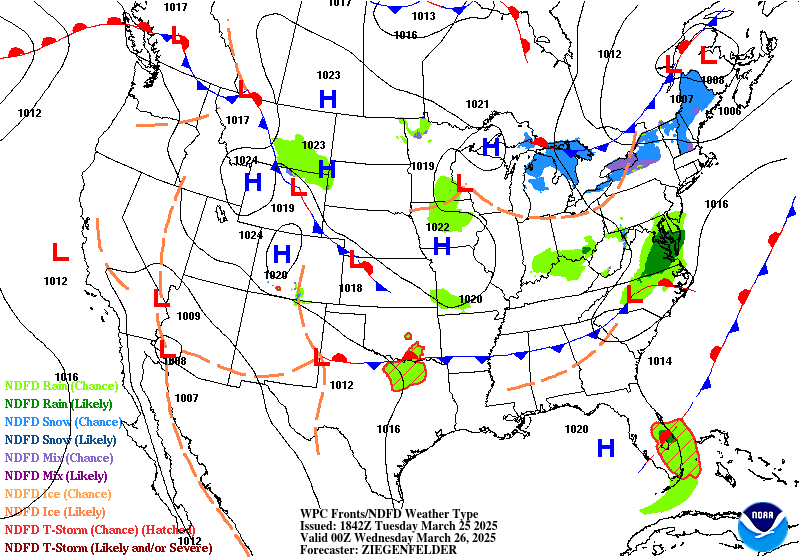The forecasts depicted below combine WPC forecasts of fronts, isobars and high/low pressure centers with the NDFD depiction of expected weather type for days .5 to 2.5 ahead. Each frame represents 6 hours. A short range forecast discussion for the CONUS is available below the short term loop.
Short Term Forecast Frontal Systems and Isobars Loop

Short Range Forecast Discussion
FXUS01 KWBC 262006 PMDSPD Short Range Forecast Discussion NWS Weather Prediction Center College Park MD 405 PM EDT Fri Jul 26 2024 Valid 00Z Sat Jul 27 2024 - 00Z Mon Jul 29 2024 ...Scattered showers and thunderstorms continue across portions of the South this evening with a risk for flash flooding in the coastal Carolinas, southern Lower Mississippi Valley, and southeastern Texas... ...Hot weather is in store across portions of the Northern Plains and Upper Midwest before a cold front brings the risk of severe thunderstorms on Saturday and heavy downpours on Sunday... ...Monsoonal thunderstorms continue for portions of the Intermountain West with isolated flash flooding possible... Scattered showers and thunderstorms will continue across portions of the South this evening, particularly for the coastal Carolinas, the southern Lower Mississippi Valley, and southeastern Texas. These showers and storms will be capable of producing heavy to locally intense downpours given plentiful moisture and several disturbances in place. Heavy rain combined with wet antecedent conditions from previous rainfall will increase the risk for scattered instances of flash flooding. As a result, the aforementioned areas continue to be highlighted by a Slight Risk of Excessive Rainfall (level 2/4). An isolated to scattered threat for flash flooding will exist more broadly across the region on Saturday, though southeast Texas will again be a focus for more concentrated heavy rainfall. By Sunday, the risk for downpours and potential flash flooding concerns shifts to the Ohio and Tennessee Valleys to round out the weekend. A cold front will advance across the Northern Plains and Upper Midwest on Saturday, bringing the potential for scattered thunderstorms capable of producing severe weather. Ahead of the front, temperatures will soar well into the 90s, with humidity making it feel even hotter. The hot and humid weather will set the stage with plenty of fuel for storms to work with. The increasing instability along with the arrival of stronger winds aloft is expected to produce at least a few intense thunderstorms. As a result, the Storm Prediction Center has issued a Slight Risk of severe weather (level 2/5) for portions of northwestern Minnesota and eastern North Dakota, with large hail and damaging winds the greatest threats. The cold front slows down on Sunday, which may allow showers and thunderstorms to evolve into more of a heavy rain and flash flooding threat across the Northern Plains and Upper Midwest. Monsoonal showers will continue across portions of the Intermountain West on Saturday, particularly from the Southwest north through the Rockies and central Great Basin. Deep moisture lingering through the area will bring the threat for some locally intense downpours. Isolated instances of flash flooding will remain possible, particularly for terrain sensitive areas such as burn scars. Forecast highs across the West will generally be below average with an upper-level trough overhead, with highs in the 80s and 90s across the Pacific Northwest, Great Basin, Rockies, and interior California, and 60s and 70s along the Pacific Coast. The Desert Southwest will be much hotter, with highs in the low to mid-110s. The hot weather and dry conditions outside of monsoonal storms will continue to foster fire weather concerns across portions of the West, with smoke from wildfires resulting in continued unhealthy air quality. Elsewhere, mainly dry weather is in store from the Midwest to the Northeast with high pressure in control. Forecast highs will warm up a bit more each day through the weekend, reaching into the mid-to upper 80s. Miller/Putnam Graphics available at https://www.wpc.ncep.noaa.gov/basicwx/basicwx_ndfd.php $$
Depicted Weather Types
- NDFD Rain (Chance) – There is chance of measurable rain (≥0.01″) at the valid time.
- NDFD Rain (Likely) – Measurable rain (≥0.01″) is likely at the valid time.
- NDFD Snow (Chance) – There is chance of measurable snowfall (≥0.01″ liquid equivalent) at the valid time.
- NDFD Snow (Likely) – Measurable snow (≥0.01″ liquid equivalent) is likely at the valid time.
- NDFD Mix (Chance) – There is a chance of measurable mixed precipitation (≥0.01″ liquid equivalent) at the valid time. “Mixed” can refer to precipitation where a combination of rain and snow, rain and sleet, or snow and sleet are forecast.
- NDFD Mix (Likely) – Measurable mixed precipitation (≥0.01″ liquid equivalent) is likely at the valid time. “Mixed” can refer to precipitation where a combination of rain and snow, rain and sleet, or snow and sleet are forecast.
- NDFD Ice (Chance) – There is a chance of measurable sleet and/or freezing rain (≥0.01″ liquid equivalent) at the valid time.
- NDFD Ice (Likely) – Measurable sleet and/or freezing rain (≥0.01″ liquid equivalent) is likely at the valid time.
- NDFD T-Storm (Chance) – There is a chance of thunderstorms at the valid time. Areas are displayed with diagonal hatching enclosed in a dark red border.
- NDFD T-Storm (Likely and/or Severe) – Thunderstorms are likely and/or the potential exists for some storms to reach severe levels at the valid time.

